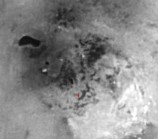Joe McCall's eye is caught by matters extraterrestrial and dinosaurian
Geoscientist 19.1 January 2009
New views of Titan

With the passage of time, scientists often come to believe that the hypotheses they themselves have created are ‘gospel truth’. But science progresses very much by revisionism and nowhere is this more true than in planetology. Titan, Saturn’s huge and haze-obscured satellite (radius ~2575km, only just exceeded by Jupiter’s Ganymede), discovered by Huygens in 1655, was long thought to posses global oceans of light hydrocarbons
1; but Cassini, on its 38th close flyby, has now shown that no such oceans exist. Nevertheless Titan does have features that are analogous to terrestrial lakes, and one 235km long, “Ontario Lacus”
2, has been recognised by radar and infra-red spectroscopy near 78°N and 250°W.
Titan possesses a nitrogen and methane atmosphere and the Visual and Infra-Red Mapping Spectrometer on Cassini has produced strong evidence that this lake contains a solution of methane, nitrogen and low molecular mass hydrocarbons. The reflectance evidence strongly suggests the presence of ethane; propane and butane are also indicated. Liquid methane is difficult to detect because of methane’s abundance in the atmosphere, but it is almost certainly present. Other possibilities are water ice, ammonia and carbon dioxide; but they are not favoured by the evidence and would be solid at Titan’s temperatures. If present their albedo would not fit with observations by Cassini.
Titan has long been thought likely to harbour life, and Ontario Lacus could well harbour some strange life form, living off the organic soup identified in this research. The new research article is very carefully written, detailing highly technical evidence and lines of argument, but this does not mean that another Cassini flyby may not, yet again, require a completely fresh revision of our view of Titan.
Refs
- Lunine, J I, Stephenson, D J & Yung, YL 1983. Ethane ocean on Titan. Science 222; 1229-1230.
- Brown, R H, Soderblom, L A, Soderblom, J M et al. 2008. The identification of liquid ethane in Titan’s Ontario Lacus. Nature 454; 607-610.